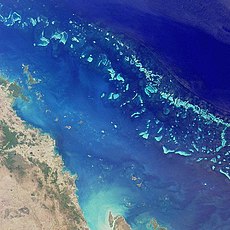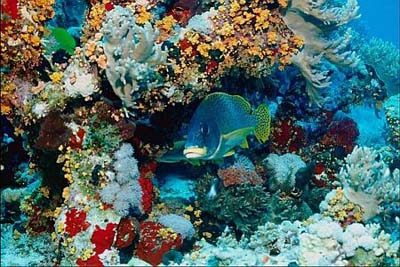(Australia's Great Barrier Reef, a UNESCO World Heritage Site)
Coral diseases have been recognized as one of the major factors in coral reef degradation worldwide; although it is not yet clear how and why these infections develop, they are likely influenced by human activities that alter the marine environment, reduce immune function in the corals, and/or increase pathogen virulence. For instance, platforms that are built for human visitation often attract sea birds, whose droppings are rich in nitrogen, phosphorus, and, occasionally, toxins such as DDT and mercury. These are washed into the water by cleaning efforts and rain, leading to increases in aspergillosis, yellow band disease, and black band disease in corals. Other sources of disease may be runoff of sunscreen, the UV-filter properties of which can lead to coral bleaching; reduced immune function during regeneration to replace body parts that are lost when tourists stand on or bump into the corals; human dislodging of cyanobacterial "black mats" that float away and infect corals downstream; and skeletal eroding band caused by infectious ciliates that enter the corals through tourist-caused abrasions and breaks.
The presence of these and other diseases were surveyed by researchers from the James Cook University, who focused on the Central and Cairns sections of the Great Barrier Reef Marine Park. They compared infection rates among corals near visitation platforms and compared these with rates observed in nearby, "non-platformed" areas. Visitors were still present at the latter category of site, but in significantly smaller numbers; additionally, they could only access the reef from non-permanent watercraft. In addition to measuring the number of sick corals, the researchers diagnosed the cause of the illness (black band disease and other cyanobacterial mats, brown band disease, white syndromes, growth anomalies, or skeletal eroding bands) and classified coral to the family and genus level in order to search for broad taxonomic patterns.
(Example of a tourism platform)
Overall, mean disease prevalence was 15-fold greater at sites with tourism platforms. At non-platformed reefs, maximum disease prevalence was only 1.1% of individuals (14 cases among 9,468 corals); this number jumped to 12% (172 cases among 7,043 corals) at platformed reefs. Each of the 5 types of diseases recorded across all corals was significantly more common at reefs with platforms.
Interestingly, disease also affected a greater range of species at the platformed sites--10 genera of 7 families, compared with 4 genera from 3 families in the areas with no platforms.
The consistently elevated prevalence of disease on reefs with visitation platforms suggests that either the structures themselves, or the activities associated with them, are reducing coral resistance to disease. This means that disease prevalence may be a useful metric of human disturbance on coral reefs. But what can be done to reduce anthropogenic impacts on the corals? Obviously, the first choice is to remove the platforms altogether and reduce--or halt--human visitation. However, this is not thought to be an economically viable plan, given the estimated 1.4 million visitors to the Great Barrier Reef each year; furthermore, studies have shown that first-hand experiences in nature increase awareness of conservation issues. Thus, removing people altogether may not be the best option.
Alternatives include installation of gutters into which sea bird guano can be washed and drained into attached wastewater tanks. Visitors might also be encouraged to wear less sunscreen, replacing it with full-body anti-UV clothing. In order to prevent physical damage to the corals, visitors could be provided with flotation devices so they won't be tempted to place their feet on the reefs while resting; alternatively, boundaries could be installed in order to keep swimmers farther away from the reefs. One ecotourism technique that has worked in some areas is to disperse visitors over a greater area rather than concentrating them in one or two sites; thus, perhaps the installation of more platforms, or the creation of low-use sites with no platforms at all, might reduce overcrowding.
In general, pathogens are known to spread more rapidly in marine systems, so the corals are already fighting a bit of an uphill battle. Disease prevalence is known to increase as temperatures warm, so climate change is likely to exacerbate the trends reported here. Hopefully some combination of mitigation tactics will be effective in reaching the delicate balance between the financial and emotional benefits of ecotourism, and the ecological benefits of making the reefs off-limits to all visitors.
---
Lamb, J.B. and Willis, B.L. 2011. Using coral disease prevalence to assess the effects of concentrating tourism activities on offshore reefs in a tropical marine park. Biological Conservation, online advance publication.
Thanks to the following websites for the photos provided in this post:
http://en.wikipedia.org/wiki/Great_Barrier_Reef
http://www.europe-autos.com/the-great-barrier-reef/
http://www.quicksilver-cruises.com/obr_platform.htm
http://www.topnews.in/coral-reefs-more-resistant-seaweed-previously-thought-2173629




No comments:
Post a Comment